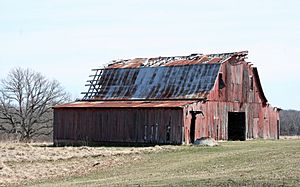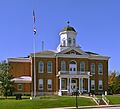Lincoln County, Missouri facts for kids
Quick facts for kids
Lincoln County
|
|
|---|---|
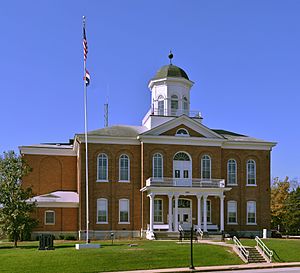
Lincoln County Courthouse in Troy
|
|
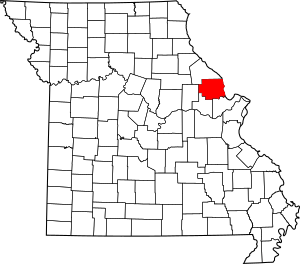
Location within the U.S. state of Missouri
|
|
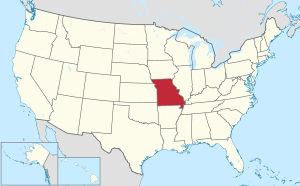 Missouri's location within the U.S. |
|
| Country | |
| State | |
| Founded | December 14, 1818 |
| Named for | Benjamin Lincoln |
| Seat | Troy |
| Largest city | Troy |
| Area | |
| • Total | 640 sq mi (1,700 km2) |
| • Land | 627 sq mi (1,620 km2) |
| • Water | 14 sq mi (40 km2) 2.2% |
| Population
(2020)
|
|
| • Total | 59,574 |
| Time zone | UTC−6 (Central) |
| • Summer (DST) | UTC−5 (CDT) |
| Congressional district | 3rd |
Lincoln County is in the eastern part of Missouri, a state in the United States. In 2020, about 59,574 people lived here. The main town, or county seat, is Troy. Lincoln County was started on December 14, 1818. It was named after Major General Benjamin Lincoln, a hero from the American Revolutionary War. This county is also part of the larger St. Louis area, which includes parts of Missouri and Illinois.
Contents
History of Lincoln County
Lincoln County has an interesting story about how it got its name. One idea comes from Major Christopher Clark. He was the first white settler to live permanently in the area. When talking to the government, he said he wanted the county named "Link-Horn." This was because he was born in a "Link-Horn" county in North Carolina. He also lived in a "Link-Horn" county in Kentucky. He wished to die in a "Link-Horn" county in Missouri.
So, he asked that the new county be called "Link-Horn." Everyone agreed. But the clerk wrote "Lincoln" instead of "Link-Horn." This is how the county got its official name. Other people believe it was named after Major General Benjamin Lincoln. He was an important leader in the Continental Army during the American Revolutionary War.
Geography and Location
Lincoln County covers a total area of about 640 square miles. Most of this is land, about 627 square miles. The rest, about 14 square miles, is water. The eastern edge of the county is along the Mississippi River. This river forms the border with the state of Illinois.
Neighboring Counties
Lincoln County shares its borders with several other counties:
- Pike County (to the north)
- Calhoun County, Illinois (to the east, across the Mississippi River)
- St. Charles County (to the southeast)
- Warren County (to the southwest)
- Montgomery County (to the west)
Main Roads and Transportation
Several important roads pass through Lincoln County. These highways help people travel around the county and to other places.
For public transportation, you can find services like Burlington Trailways and OATS Transit. The BNSF Railway also has train lines running through the county.
Population and People
The population of Lincoln County has grown a lot over the years. In 1820, only 1,662 people lived here. By 2020, the population had reached 59,574.
| Historical population | |||
|---|---|---|---|
| Census | Pop. | %± | |
| 1820 | 1,662 | — | |
| 1830 | 4,059 | 144.2% | |
| 1840 | 7,449 | 83.5% | |
| 1850 | 9,421 | 26.5% | |
| 1860 | 14,210 | 50.8% | |
| 1870 | 15,960 | 12.3% | |
| 1880 | 17,426 | 9.2% | |
| 1890 | 18,346 | 5.3% | |
| 1900 | 18,352 | 0.0% | |
| 1910 | 17,003 | −7.4% | |
| 1920 | 15,956 | −6.2% | |
| 1930 | 13,929 | −12.7% | |
| 1940 | 14,395 | 3.3% | |
| 1950 | 13,478 | −6.4% | |
| 1960 | 14,783 | 9.7% | |
| 1970 | 18,041 | 22.0% | |
| 1980 | 22,193 | 23.0% | |
| 1990 | 28,892 | 30.2% | |
| 2000 | 38,944 | 34.8% | |
| 2010 | 52,566 | 35.0% | |
| 2020 | 59,574 | 13.3% | |
| U.S. Decennial Census 1790-1960 1900-1990 1990-2000 2010-2020 2020 |
|||
In 2020, most people in Lincoln County identified as White. There were also people who identified as Black or African American, Native American, Asian, Pacific Islander, or from two or more races. About 2.6% of the population identified as Hispanic or Latino.
Schools and Learning
Lincoln County has many schools for students of all ages.
Public Schools
Several public school districts serve the county:
- Silex R-I School District in Silex
- Silex Elementary School (Kindergarten to 6th grade)
- Silex High School (7th to 12th grade)
- Elsberry R-II School District in Elsberry
- Clarence Cannon Elementary School (Pre-Kindergarten to 4th grade)
- Ida Cannon Middle School (5th to 8th grade)
- Elsberry High School (9th to 12th grade)
- Lincoln County R-III School District in Troy
- Early Childhood Education Center (Pre-K programs)
- Boone Elementary School (K-5)
- Claude Brown Elementary School (K-5)
- Cuivre Park Elementary School (K-5)
- Hawk Point Elementary School (K-5)
- Lincoln Elementary School (K-5)
- Main Street Elementary School (K-5)
- William R. Cappel Elementary School (K-5)
- Troy Middle School (6-8)
- Troy South Middle School (6-8)
- Ninth Grade Center (9th grade)
- Troy Buchanan High School (10-12)
- New Horizons High School (10-12)
- Winfield R-IV School District in Winfield
- Winfield Elementary School (Pre-K to 2nd grade)
- Winfield Intermediate School (3rd to 5th grade)
- Winfield Middle School (6th to 8th grade)
- Winfield High School (9th to 12th grade)
- Wright City R-II School District in Wright City (serves southern parts of Lincoln County)
- Pike County R-III School District
- Warren County R-III School District
Private Schools
There are also several private schools in Lincoln County:
- Calvary Christian School in Winfield (1st to 12th grade) – a Pentecostal school
- First Baptist Christian Academy in Troy (Kindergarten to 8th grade) – a Baptist school
- Immaculate Conception School in Old Monroe (K-8) – a Roman Catholic school
- Sacred Heart School in Troy (K-8) – a Roman Catholic school
- St. Alphonsus School in Silex (Pre-K to 8th grade) – a Roman Catholic school
- Troy Holiness School in Troy (K-12) – a Methodist school
Public Libraries
The county has the Powell Memorial Library, where you can find books and other resources.
Cities, Towns, and Communities
Lincoln County is home to many different communities.
Cities and Villages
- Cave
- Chain of Rocks
- Elsberry
- Foley
- Fountain N' Lakes
- Hawk Point
- Moscow Mills
- Old Monroe
- Silex
- Troy (the county seat)
- Truxton
- Whiteside
- Winfield
Unincorporated Communities
These are smaller communities that are not officially organized as cities or villages.
Images for kids
See also
 In Spanish: Condado de Lincoln (Misuri) para niños
In Spanish: Condado de Lincoln (Misuri) para niños


